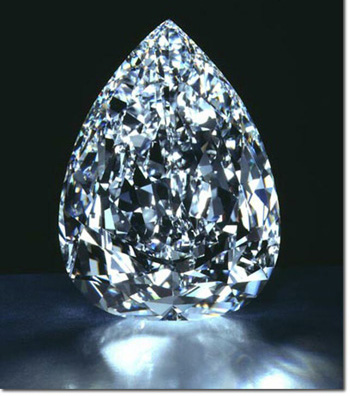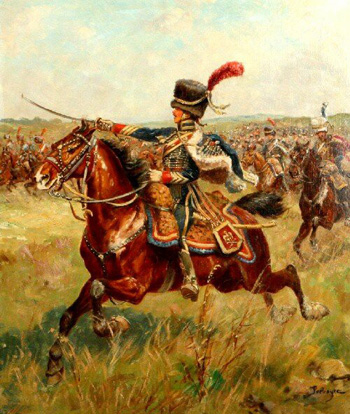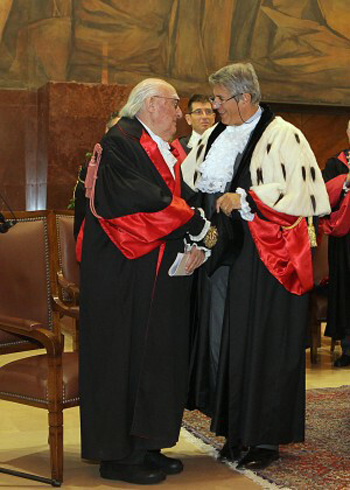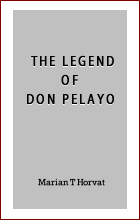Ambiences and Tendencies
 |
 |
 |
 |
 |
 |
 |
Myth & Transcendence
One of the more characteristic aspects of the Revolution is its process of de-mythfication or desacralization, that is, its attacks against what it calls myths, against what is sacred.
For us to understand these attacks, it is necessary to understand the notion they have of myth and sacred things. To apprehend the depth of this question, consider these lines by Edmond Rostand, a 19th century French poet and dramatist. In his play Chantecler, Rostand imagines the cock – the main protagonist of the piece – making a salute to the sun. The cock says: “Glory to you, O sun, without whose golden magic, things would be no more than what they are.”
 To illustrate its meaning, consider a simple colored paper; when a ray of sun hits it, that paper displays brilliant, even magnificent aspects. In fact, the rays give that paper a special beauty that would not appear if it were not for the sun.
To illustrate its meaning, consider a simple colored paper; when a ray of sun hits it, that paper displays brilliant, even magnificent aspects. In fact, the rays give that paper a special beauty that would not appear if it were not for the sun.
I remember that when I was a boy, on my way to school, every day I walked by a house with a mansard that had an unwashed window with a broken glass. The lady who owned the house never cleaned that window or changed the broken glass. Despite its dirty state, when the sun hit that window it brought forth a truly splendorous reflection. Onto that dirty window the sun shone, making it a marvelous mirror.
I enjoyed speculating on the many meanings of that reflection: the sky illuminates what is dirty, reflecting itself even in the debris and shining in it in a special way.
So, when a man observes things with a philosophic spirit and the spirit of faith, he sees on them reflections of a superior order.
The sun being reflected in a piece of broken glass has a certain analogy with a diamond, although the diamond is much more than the broken glass. But, the diamond, in its turn, is analogous with some marvelous stone that would exist in the terrestrial paradise, in comparison to which the diamond would seem a piece of broken glass. That sparkling gem in the terrestrial paradise, however, next to some jewel substance in the celestial paradise, would seem like nothing more than a broken glass.
 This celestial substance, in its turn, is nothing but a broken glass next to the intelligence of the least intelligent of men, who, in sequence, is an image of an intelligent man. Then, the intelligent man is an image of the angel, and the latter is an image of God. Thus, rising from one step to another, we can reach the infinite perfection of God Our Lord.
This celestial substance, in its turn, is nothing but a broken glass next to the intelligence of the least intelligent of men, who, in sequence, is an image of an intelligent man. Then, the intelligent man is an image of the angel, and the latter is an image of God. Thus, rising from one step to another, we can reach the infinite perfection of God Our Lord.
The well formed mind always seeks in one thing the image of a higher one. It always directs itself toward the consideration of higher things and is eager to examine these analogies until it reaches God Our Lord. Following this path, we can analyze all created things to climb up the ladder until we reach God himself.
Above all these natural considerations, we can also say this about grace, because grace itself is much more than the sun. It shines and enlightens even more than the sun illuminates natural things. And grace, in its turn, is a supernatural gift, a created gift that is similar to God. Therefore, through grace we can have a better idea of how God is.
The result of this tendency to rise to higher planes is that any people with a minimum of sanity tries to present reality in order to reflect a superior order.
 For example, when we consider a military man, we like to see him dressed in a uniform that invites us to think about the splendor of courage, the distinctive trait of the military spirit. Rising in a crescendo from one step to another leads us, at the end of the process, to the contemplation of the courage of St. Michael the Archangel, who expelled Lucifer from Heaven. This consideration of things gives us a special appreciation for the military uniform.
For example, when we consider a military man, we like to see him dressed in a uniform that invites us to think about the splendor of courage, the distinctive trait of the military spirit. Rising in a crescendo from one step to another leads us, at the end of the process, to the contemplation of the courage of St. Michael the Archangel, who expelled Lucifer from Heaven. This consideration of things gives us a special appreciation for the military uniform.
When we consider the priest, above all the priest in the exercise of his functions, we envisage in him the sacrality of his mission; in the sacrality of his mission we think about God. So, when the priest wears highly adorned vestments, mainly in the ceremonies of his ministry, it is to give us an idea of the importance of his mission, and, through his mission, we think of God.
We could continue these examples with other professions, as, for example, that of academia. It is normal for a professor to deliver his class wearing a toga. Why? It is to highlight the splendor of the professor’s métier, the gravity and distinction of his mission. The apparel accentuates the idea of the mission; the idea of the mission leads us to God, source of all truth and Master of all professors.
 Thus, there is a natural tendency in the man who is not an atheist to always seek some higher reality present in the lower thing.
Thus, there is a natural tendency in the man who is not an atheist to always seek some higher reality present in the lower thing.
The tradition of Catholic Civilization applied this process in countless customs that still live in our days. This is what the modern man considers to be a myth. To see in something the reflection of a superior reality is, for the modern man, to make a myth of it. It would be to link the reality to something imaginary that would be above it.
So, that which for us is a series of rising steps leading us to God, for an atheistic is a ladder of myths that lead us to a lie. This is because for him God does not exist and, consequently, the idea that everything must lead to God is a myth, nothing but empty poetry.
Hence, modern men have a tendency toward what they call de-mythfication. That is, to divest all things of their ornaments, to deprive them of all forms of beauty, in order to present them in their most prosaic reality. This is to obviate the myths, this is de-mythfication.
What the modern man wants is to destroy the projection of the reality to a superior and higher sphere.

For us to understand these attacks, it is necessary to understand the notion they have of myth and sacred things. To apprehend the depth of this question, consider these lines by Edmond Rostand, a 19th century French poet and dramatist. In his play Chantecler, Rostand imagines the cock – the main protagonist of the piece – making a salute to the sun. The cock says: “Glory to you, O sun, without whose golden magic, things would be no more than what they are.”

Sunlight gives to simple things a splendorous aspect, which invite us to think of God
I remember that when I was a boy, on my way to school, every day I walked by a house with a mansard that had an unwashed window with a broken glass. The lady who owned the house never cleaned that window or changed the broken glass. Despite its dirty state, when the sun hit that window it brought forth a truly splendorous reflection. Onto that dirty window the sun shone, making it a marvelous mirror.
I enjoyed speculating on the many meanings of that reflection: the sky illuminates what is dirty, reflecting itself even in the debris and shining in it in a special way.
So, when a man observes things with a philosophic spirit and the spirit of faith, he sees on them reflections of a superior order.
The sun being reflected in a piece of broken glass has a certain analogy with a diamond, although the diamond is much more than the broken glass. But, the diamond, in its turn, is analogous with some marvelous stone that would exist in the terrestrial paradise, in comparison to which the diamond would seem a piece of broken glass. That sparkling gem in the terrestrial paradise, however, next to some jewel substance in the celestial paradise, would seem like nothing more than a broken glass.

The brightest diamond is an image of man's intelligence and God's wisdom
The well formed mind always seeks in one thing the image of a higher one. It always directs itself toward the consideration of higher things and is eager to examine these analogies until it reaches God Our Lord. Following this path, we can analyze all created things to climb up the ladder until we reach God himself.
Above all these natural considerations, we can also say this about grace, because grace itself is much more than the sun. It shines and enlightens even more than the sun illuminates natural things. And grace, in its turn, is a supernatural gift, a created gift that is similar to God. Therefore, through grace we can have a better idea of how God is.
The result of this tendency to rise to higher planes is that any people with a minimum of sanity tries to present reality in order to reflect a superior order.

A military uniform should reflect courage and remind us of the angelical fight
When we consider the priest, above all the priest in the exercise of his functions, we envisage in him the sacrality of his mission; in the sacrality of his mission we think about God. So, when the priest wears highly adorned vestments, mainly in the ceremonies of his ministry, it is to give us an idea of the importance of his mission, and, through his mission, we think of God.
We could continue these examples with other professions, as, for example, that of academia. It is normal for a professor to deliver his class wearing a toga. Why? It is to highlight the splendor of the professor’s métier, the gravity and distinction of his mission. The apparel accentuates the idea of the mission; the idea of the mission leads us to God, source of all truth and Master of all professors.

The professors' togas highlight the gravity of their métier
The tradition of Catholic Civilization applied this process in countless customs that still live in our days. This is what the modern man considers to be a myth. To see in something the reflection of a superior reality is, for the modern man, to make a myth of it. It would be to link the reality to something imaginary that would be above it.
So, that which for us is a series of rising steps leading us to God, for an atheistic is a ladder of myths that lead us to a lie. This is because for him God does not exist and, consequently, the idea that everything must lead to God is a myth, nothing but empty poetry.
Hence, modern men have a tendency toward what they call de-mythfication. That is, to divest all things of their ornaments, to deprive them of all forms of beauty, in order to present them in their most prosaic reality. This is to obviate the myths, this is de-mythfication.
What the modern man wants is to destroy the projection of the reality to a superior and higher sphere.

Posted January 22, 2016
______________________
______________________








